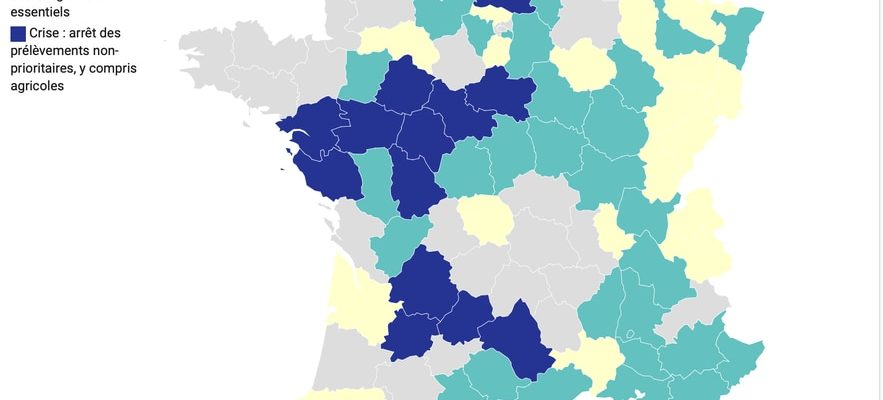After the historic drought of the summer of 2022 and a weak reconstitution of the water tables during the winter, the number of departments considered to be in drought continues to expand at the start of summer 2023. As of July 9, 67 departments are placed in a state of alert (drought, increased or crisis) – not to mention the so-called “vigilant” territories, which could increase this number in the weeks to come. To cope with water shortages in these departments, the prefects impose restrictions on its use by decree and according to the level of alert.
The state of alert – the lowest on the map below – imposes the reduction of withdrawals for agricultural purposes of less than 50% (or a ban up to three days a week), prohibits nautical activities, the maneuver of valve, and the watering of gardens between 11 a.m. and 6 p.m., as well as that of green spaces, golf courses at any time. It is also forbidden to wash your car, the facade of your house or your roof. Or to fill and drain private swimming pools of more than one cubic meter.
67 departments are on drought alert and affected by water restrictions as of July 9.
© / L’Express.fr
The heightened state of alert implies the reduction of withdrawals for agricultural purposes greater than or equal to 50% (or a ban greater than or equal to 3.5 days per week), even stronger limitations of withdrawals for watering gardens, green spaces, golf courses and washing cars; prohibits the filling or emptying of private and collective swimming pools. This level concerns 29 departments.
The state of crisis – the highest – marks the end of non-priority levies, including for agricultural purposes. Only withdrawals to ensure the exercise of priority uses (health, civil security, drinking water, sanitation) are authorized. This level currently concerns 15 departments such as Oise, Loiret, Sarthe, Maine-et-Loire, Vendée, Pyrénées Orientales and Dordogne.
According to Bureau of Geological and Mining Research (BRGM), a very large majority of French groundwater tables (66%) remained at levels below normal on June 1, with many sectors showing low to very low levels, particularly in the south-east of France. “For the next quarter, groundwater levels should remain lower. Recharge episodes should remain occasional and not very intense and only impact reactive groundwater, except for exceptional rainfall events, specifies the office. The situation will have to be particularly monitored on groundwater which are currently displaying low to very low levels as well as on sectors strongly solicited by samples.
A heat wave in the southeast from Sunday
An episode of heat wave should also affect, this Sunday July 9, the south-eastern part of the country, with four departments placed in orange vigilance from the morning, announced Saturday Météo-France. The Rhône, Ain, Isère and Alpes-Maritimes regions are affected by this alert caused by a “non-exceptional heatwave episode for the season, but the persistence of which requires particular vigilance, especially for sensitive or exposed people”, specifies Météo-France. In Lyon and Bourg-en-Bresse, the mercury should notably reach 38 degrees, indicates the meteorological institute. This alert will continue on Monday.
From Sunday, 23 departments are also placed in yellow vigilance for a heat wave in the eastern part of France. “This Sunday, the maximum temperatures are between 34 to 37 degrees, specifies the weather report. Monday, the maximum will be up in the Paca region with 37 to 40 degrees. The end of this episode is of course still uncertain, but the risk seems to be sustainable in the south-east of the country”.
Reinforced vigilance alerts concerning thunderstorms are also underway in ten departments for “risk of violent phenomenon”, such as strong gusts or heavy rainfall. These orange alerts are concentrated in the northeast of France until 7 p.m., then should subside in the evening. “The regions on the fringes of the departments in orange (Oise, Nord, Paris region, Alsace) are not immune to strong storms”, specifies Météo France.
